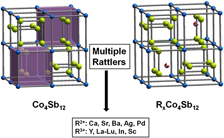Crossref Citations
This article has been cited by the following publications. This list is generated based on data provided by
Crossref.
Biswas, Krishnendu
Subramanian, M.A.
Good, Morris S.
Roberts, Kamandi C.
and
Hendricks, Terry J.
2012.
Thermal Cycling Effects on the Thermoelectric Properties of n-Type In,Ce-Based Skutterudite Compounds.
Journal of Electronic Materials,
Vol. 41,
Issue. 6,
p.
1615.
Rafiee, M.
Siadatan, A.
and
Afjei, E.
2012.
Improving the hybrid electric vehicles efficiency, using Si<inf>0.7</inf>Ge<inf>0.3</inf> and Bi<inf>2</inf>Te<inf>3</inf> thermoelectric materials.
p.
445.
Rafiee, M.
Siadatan, A.
Afjei, E.
and
Abadi, E. Zarei Ali
2012.
Improving the efficiency of thermal power plant using thermoelectric material.
p.
450.
Eilertsen, James
Subramanian, M.A.
and
Kruzic, J.J.
2013.
Fracture toughness of Co4Sb12 and In0.1Co4Sb12 thermoelectric skutterudites evaluated by three methods.
Journal of Alloys and Compounds,
Vol. 552,
Issue. ,
p.
492.
Guan, Zhi-Ping
and
Dunand, David C.
2013.
Compressive creep behavior of cast Bi2Te3.
Materials Science and Engineering: A,
Vol. 565,
Issue. ,
p.
321.
Grytsiv, A.
Rogl, P.
Michor, H.
Bauer, E.
and
Giester, G.
2013.
In y Co4Sb12 Skutterudite: Phase Equilibria and Crystal Structure.
Journal of Electronic Materials,
Vol. 42,
Issue. 10,
p.
2940.
Gaultois, Michael W.
Sparks, Taylor D.
Borg, Christopher K. H.
Seshadri, Ram
Bonificio, William D.
and
Clarke, David R.
2013.
Data-Driven Review of Thermoelectric Materials: Performance and Resource Considerations.
Chemistry of Materials,
Vol. 25,
Issue. 15,
p.
2911.
Zou, Liang
Zhang, Bo-Ping
Ge, Zhen-Hua
and
Zhang, Li-Juan
2014.
Enhancing thermoelectric properties of Cu1.8+xSe compounds.
Journal of Materials Research,
Vol. 29,
Issue. 9,
p.
1047.
Rogl, G.
Grytsiv, A.
Yubuta, K.
Puchegger, S.
Bauer, E.
Raju, C.
Mallik, R.C.
and
Rogl, P.
2015.
In-doped multifilled n-type skutterudites with ZT= 1.8.
Acta Materialia,
Vol. 95,
Issue. ,
p.
201.
Tang, Yun-Qiao
Ge, Zhen-Hua
Chen, Yue-Xing
Qin, Peng
Feng, Jing
and
He, Jiaqing
2017.
Thermoelectric properties of Cu2Se prepared by solution phase methods and spark plasma sintering.
Journal of the European Ceramic Society,
Vol. 37,
Issue. 15,
p.
4687.
Khovaylo, V. V.
Korolkov, T. A.
Voronin, A. I.
Gorshenkov, M. V.
and
Burkov, A. T.
2017.
Rapid preparation of InxCo4Sb12 with a record-breaking ZT = 1.5: the role of the In overfilling fraction limit and Sb overstoichiometry.
Journal of Materials Chemistry A,
Vol. 5,
Issue. 7,
p.
3541.
Michi, Richard A.
Kim, Gwansik
Kim, Byung-Wook
Lee, Wooyoung
and
Dunand, David C.
2018.
Compressive creep behavior of hot-pressed Mg1.96Al0.04Si0.97Bi0.03.
Scripta Materialia,
Vol. 148,
Issue. ,
p.
10.
Benyahia, M.
Ohorodniichuk, V.
Leroy, E.
Dauscher, A.
Lenoir, B.
and
Alleno, E.
2018.
High thermoelectric figure of merit in mesostructured In0.25Co4Sb12 n-type skutterudite.
Journal of Alloys and Compounds,
Vol. 735,
Issue. ,
p.
1096.
Smith, Eric
and
Hosseini, Seyed Ehsan
2019.
Human Body Micro-power plant.
Energy,
Vol. 183,
Issue. ,
p.
16.
Novikov, S. V.
Burkov, A. T.
Tang, X.
Yan, Y.
and
Orekhov, A. S.
2019.
Thermoelectric Properties of In0.2Ce0.1Co4Sb12.3 Ribbons Prepared by the Rapid-Quenching Technique.
Semiconductors,
Vol. 53,
Issue. 5,
p.
583.
Alleno, E.
Benyahia, M.
Vaney, J. B.
Provost, K.
Paul-Boncour, V.
Monnier, J.
Dauscher, A.
and
Lenoir, B.
2020.
High thermoelectric figure of merit in well optimized YbyCo4Sb12.
Journal of Materials Chemistry C,
Vol. 8,
Issue. 47,
p.
17034.
Yelgel, Övgü Ceyda
and
Ballikaya, Sedat
2020.
Theoretical and experimental evaluation of thermoelectric performance of alkaline earth filled skutterudite compounds.
Journal of Solid State Chemistry,
Vol. 284,
Issue. ,
p.
121201.
Erden, Fuat
Akgul, Bekir
Danaci, Ilhan
and
Oner, M. Rasit
2023.
Thermoelectric and thermomechanical properties of invar 36: Comparison with common thermoelectric materials.
Journal of Alloys and Compounds,
Vol. 932,
Issue. ,
p.
167690.





